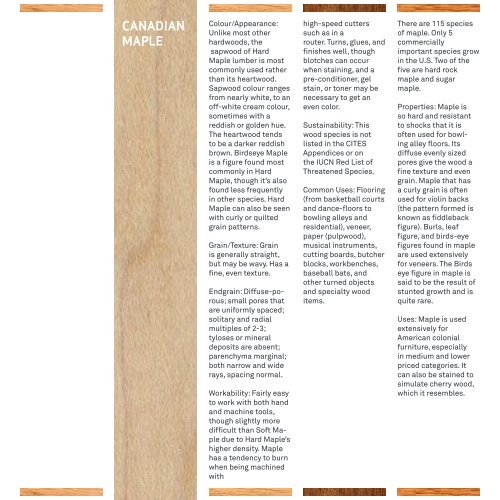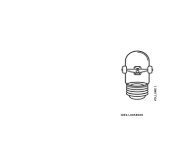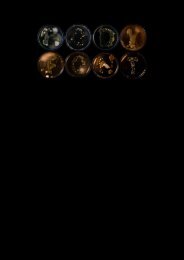istd booklet cover
Create successful ePaper yourself
Turn your PDF publications into a flip-book with our unique Google optimized e-Paper software.
CANADIAN<br />
MAPLE<br />
Colour/Appearance:<br />
Unlike most other<br />
hardwoods, the<br />
sapwood of Hard<br />
Maple lumber is most<br />
commonly used rather<br />
than its heartwood.<br />
Sapwood colour ranges<br />
from nearly white, to an<br />
off-white cream colour,<br />
sometimes with a<br />
reddish or golden hue.<br />
The heartwood tends<br />
to be a darker reddish<br />
brown. Birdseye Maple<br />
is a figure found most<br />
commonly in Hard<br />
Maple, though it’s also<br />
found less frequently<br />
in other species. Hard<br />
Maple can also be seen<br />
with curly or quilted<br />
grain patterns.<br />
Grain/Texture: Grain<br />
is generally straight,<br />
but may be wavy. Has a<br />
fine, even texture.<br />
Endgrain: Diffuse-porous;<br />
small pores that<br />
are uniformly spaced;<br />
solitary and radial<br />
multiples of 2-3;<br />
tyloses or mineral<br />
deposits are absent;<br />
parenchyma marginal;<br />
both narrow and wide<br />
rays, spacing normal.<br />
Workability: Fairly easy<br />
to work with both hand<br />
and machine tools,<br />
though slightly more<br />
difficult than Soft Maple<br />
due to Hard Maple’s<br />
higher density. Maple<br />
has a tendency to burn<br />
when being machined<br />
with<br />
high-speed cutters<br />
such as in a<br />
router. Turns, glues, and<br />
finishes well, though<br />
blotches can occur<br />
when staining, and a<br />
pre-conditioner, gel<br />
stain, or toner may be<br />
necessary to get an<br />
even color.<br />
Sustainability: This<br />
wood species is not<br />
listed in the CITES<br />
Appendices or on<br />
the IUCN Red List of<br />
Threatened Species.<br />
Common Uses: Flooring<br />
(from basketball courts<br />
and dance-floors to<br />
bowling alleys and<br />
residential), veneer,<br />
paper (pulpwood),<br />
musical instruments,<br />
cutting boards, butcher<br />
blocks, workbenches,<br />
baseball bats, and<br />
other turned objects<br />
and specialty wood<br />
items.<br />
There are 115 species<br />
of maple. Only 5<br />
commercially<br />
important species grow<br />
in the U.S. Two of the<br />
five are hard rock<br />
maple and sugar<br />
maple.<br />
Properties: Maple is<br />
so hard and resistant<br />
to shocks that it is<br />
often used for bowling<br />
alley floors. Its<br />
diffuse evenly sized<br />
pores give the wood a<br />
fine texture and even<br />
grain. Maple that has<br />
a curly grain is often<br />
used for violin backs<br />
(the pattern formed is<br />
known as fiddleback<br />
figure). Burls, leaf<br />
figure, and birds-eye<br />
figures found in maple<br />
are used extensively<br />
for veneers. The Birds<br />
eye figure in maple is<br />
said to be the result of<br />
stunted growth and is<br />
quite rare.<br />
Uses: Maple is used<br />
extensively for<br />
American colonial<br />
furniture, especially<br />
in medium and lower<br />
priced categories. It<br />
can also be stained to<br />
simulate cherry wood,<br />
which it resembles.







